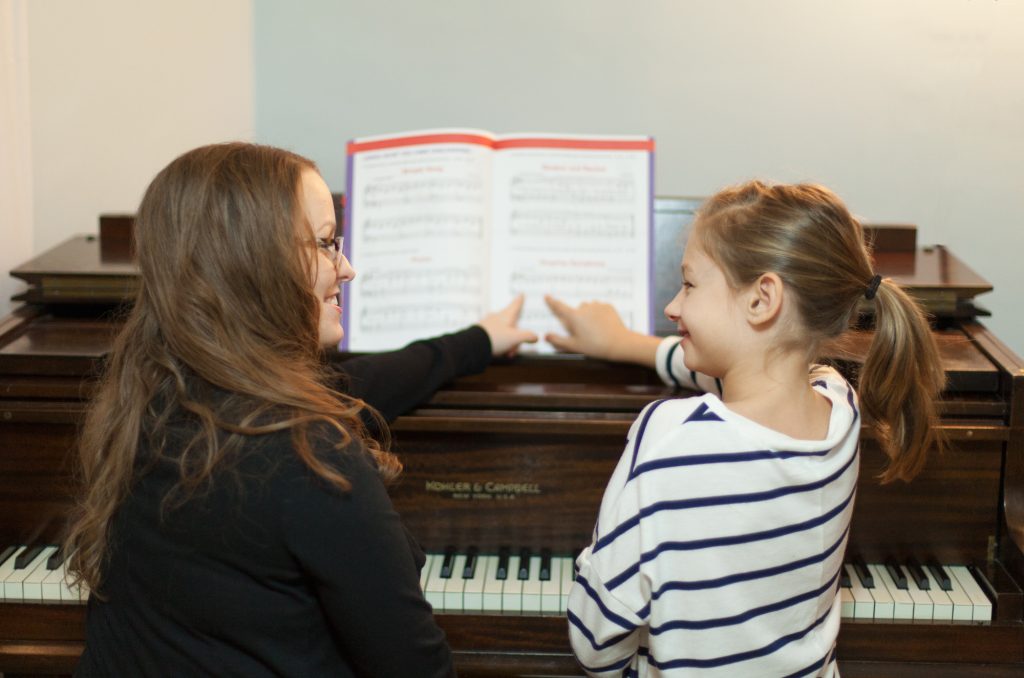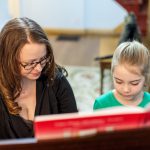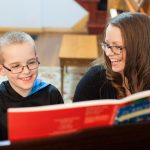Teaching Tips
Pedagogy is the science of teaching. Students are more successful when we move from known concepts to unknown concepts and/or gross motor to fine motor skills. Preparation is key. Guiding students to be successful will keep them excited to learn without feeling overwhelmed. Think: how can I incorporate all the learning styles: kinesthetic, visual, aural? How can I develop all the musicianship concepts: reading, writing, ear-training, improvisation, transposition? When we’re constantly asking questions we are constantly improving as teachers.
Teaching Tips
- Teach a pattern by rote, then have the student find it in the music. They can play it to check even if the answer is wrong, guide them to discover if it is a match or not.
- Practice speaking the note names prior to playing the song from the music
- Practice clapping the rhythm using number counting or ta titi counting system
- Practice speaking the note names in rhythm
- Read a phrase, then find the match in the music
- Determine the matching, similar, and different phrases
- Have student use staff and note heads to move notes to specific spots
- Have students write well known phrases from well known songs on the staff. Large dry erase staff
- Listening to the recording or a live performance
- Listening and watching the teacher play future songs each week (the next one on the list, but also one later on in the book)
- Teacher plays known songs and student has to determine which one. Have student play to check
- Sing the songs with words of the next several pieces so they become well known
- Have the student figure out, discover, or find a certain phrase independently. Maybe give him/her the starting note or two.
- Play listening games with patterns from the songs they have done and will be doing. A. The student plays a motive you tell them to play. B. The student watches you play the notes and copies C. The student hears the notes and plays them back without looking.
- Do an improvisation activity weekly or monthly.
- Have the student change something from the written music. Just one thing. They determine it in advance and then play it with the change
- Have the student create their own song using only certain notes or rhythms.
- Play a left hand accompaniment for the student while he/she creates his/her own melody.
- Try improvising using only the black keys while you play an open 5th and 6th underneath
- Have the student change a well known by ear piece and play it
- Teacher makes up a short pattern and the student copies it. Do several patterns copying. This can be just rhythm or simple rhythm and notes.
- Teacher plays a “call” or a short pattern and the Student plays an answer. The Call is always the same notes and rhythms.
- Student plays the “call” and teacher plays an improvised answer.
- Have the student play music in different positions starting with C five finger scale and moving to G
- Have student find a by ear piece usually starting in C position in another position (you may have to find positions that shares similar scales like C, G, F and introduce new five finger scales
More Teaching Tips
- Select smaller chunks.
- Review the smaller bits before adding more.
- Add short new phrases to the longer known phrases.
- Sometimes you just have to practice two notes then three notes, then move on to the motive and phrase.
- Always demonstrate new music at a significantly slower tempo for students of all ages.
- Remember these students are regular people with other things going on in their lives.
- Practice a new piece or section several times before they go home for the week.
- The next lesson should focus on perfecting that new section before adding more.
- Think of adding only one new concept each week–notes, then dynamics, then technique.
- Preparation is key to success.
- Prepare the student for a new concept in the lesson with warm-ups.
- Review the scale, triad, cadence, or arpeggios related to the song you’re working on.
- Model a tricky pattern by rote, then have the student find the pattern in the music.
- Score study is your friend. Have the student find similar patterns and phrases in the music prior to learning it. Practicet hose patterns before putting it together. This helps it feel like an achievable goal.
- Don’t rush the process.
- Use supplemental music at their level to build foundational skills before moving on to the next level.
- Use your resources. Find free or cheap blogs, printables, to get ideas. Color In My Piano is a great resource for teachers.







